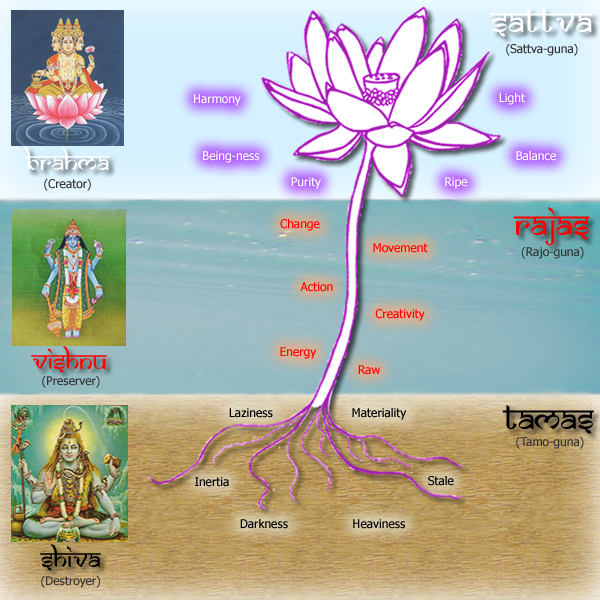Every new year, we make resolutions and get excited for the new changes we want to bring into our lives, sometimes too rapidly and without proper understanding of self. In the next couple of weeks this motivation can fade or you may feel just overwhelmed at what expectations you have set up for yourself. Regardless of whatever resolutions you may have set, the mind is our greatest obstacle in achieving them. It is important to understand that most problems stem from not understanding the mind, and how it functions for and against us. Healing is a process, and by using the Ayurvedic principles of the 3 gunas (universal energies). These three primal qualities are the main powers of cosmic intelligence, and guide spiritual growth. We all have elements of each guna within ourselves.
These three energies mirror the growth of the lotus flower. This flower is inspirational, due to the fact that it is one of the few that grows from the mud. In this context, the energy of Tamas is the mud. This is where darkness, inertia and laziness marinate. People who are in a Tamas mind state may experience depression, unhealthy attachments, greed and a general lack of excitement for life. Tamasic people allow negativity to run their life, and are good at avoiding deep seeded problems within themselves. Tamas is not inherently a bad energy, it can be grounding and sedative during times of high Rajas (activity or stimulation) and is necessary in rooting ourselves.
The stem of the lotus is reflective of the energy of Rajas. This is a highly energetic guna, and it can cause change and transformation as well as imbalance. People who are in a Rajas mind state are ambitious, working a lot and may be in a creative upswing. With all of the movement that Rajas brings, it can also look like restlessness, anger, selfishness and anxiety. Rajastic people are not awakened to their spiritual purpose, and still allow the ego to dominate their choices and outlooks. It is important to note that Rajas and Tamas work in a tandem cycle; such as working too hard and then collapsing into fatigue.
The lotus flower is Sattva. It is the balance between activity and inertia. People who experience Sattvic energy are happy, intelligent, hold wisdom, are spiritually connected and have self control. Clarity, peace and love are the uniting forces of Sattvic energy. Sattvic people are content, and are harmonious and grounded in their interactions with others and themselves.
Now that we have gone through the three gunas, here are the steps in Ayurveda for mental healing:
This is the first step in mental healing. We want to move from the dark, ignorant and heavy spaces in our minds into a more motivational, creative and transformational mindset. This is where we need to stop suffering and learn from it. We need to confront the pain and suppressed emotions that have been keeping us dormant by being receptive and bring new energies into our lives.
Rajas –> Sattva
This is the time to let go of individual hurts and sorrow, and consider the entire human condition. Life creates suffering in order for us to help us grow. Rain has to come in order for the flower to grow. Manifesting balance from a period of transformation and movement may be challenging. This is also a time for selflessness and charity, and thinking about your place in the fabric of humanity.
Maintaining Sattva
This is the stage where we graduate from thinking through the lens of humanity to the lens of the universe. Love and awareness are universal forces for accessing and creating Sattvic energy. This stage requires spiritual practice, such as meditation, yoga and mantras. The ultimate goal of Ayurveda is to bring your true self out, and inner peace is the dominant force in this lifelong journey.
In this highly capitalistic society, constant expansion is continually prioritized over balance. The outside world does not reflect the Sattvic energy that we want to cultivate as individuals. We have the ability to recognize where our current mindset is at with the helpful outline of the trigunas. We all want (or want to want) to get to universal peace and maintain our Sattvic energy, and it is important to have compassion and patience for ourselves in our mental healing journey.
References:
- Ayurveda and the Mind: Healing of the Consciousness by Dr. David Frawley
- Fitsri.com
- Vedanet.com
- Photo
